Key Points:
The intellectual property (IP) industry has been continuously growing in recent years and has become an important pillar in various fields such as entertainment, technology, and consumer goods. According to Business Research, the global IP market is expected to reach $26.6 billion by 2033. However, the traditional IP industry still faces challenges such as uneven revenue distribution, complex IP registration processes, geographical restrictions, and IP infringement. Story Protocol proposes a more efficient IP management solution based on blockchain and AI technology, aiming to address issues like uneven IP revenue distribution and complex registration processes. However, it is worth noting that Story Protocol currently cannot resolve the infringement issues faced by the traditional IP industry.
Story Protocol focuses on intellectual property (IP), with its core being the on-chain management of IP assets, combined with smart contracts to set authorization and revenue distribution rules, allowing for more efficient circulation and monetization of creative and derivative content. Story Protocol has become a market focus due to its unique narrative and has received three rounds of funding led by top VC a16z. The founder of Story Protocol, S.Y. Lee, has a strong background in media and politics, which provides Story Protocol with a unique perspective and resources.
Story Protocol allows for direct buying, licensing, and trading of IP, expanding market size and reducing third-party intermediary costs. The core mechanism of Story Protocol can be summarized as programmable IP and the ATCP/IP framework. Based on programmable IP, smart contracts automatically distribute royalties between the original IP creators and derivative work creators according to preset terms of the original IP, without the need for third-party intervention, ensuring fair profit distribution. Additionally, Story Protocol introduces the ATCP/IP framework, using IP as a core asset, allowing multiple AI agents to autonomously trade IP, including training data, creative styles, and investment strategies. The initial supply of Story Protocol's native token $IP is 1 billion, with an initial unlock supply of 25%. Among this, 41.6% of the tokens held by early supporters and core contributors are still locked, with unlocking expected to continue for about two years.
The Story Protocol mainnet officially launched on February 13, 2025. As of the time of writing, Story Protocol has a total of 762,000 addresses and a daily transaction volume of 231,000. There are 37 mainnet validators for Story Protocol, with a total staking amount exceeding 300 million $IP, and an APR of approximately 9.24%. However, after the mainnet launch and token issuance, the number of active accounts in Story Protocol has stabilized. The main directions of the Story Protocol ecosystem projects include IPFi, AI, consumer applications, and infrastructure. Most projects in its ecosystem are still in the early stages; among the 148 projects currently in the ecosystem, some have ceased operations while others strive to catch up. This report will focus on key projects in the IPFi, AI, consumer applications, and infrastructure directions.
The IPFi direction includes Unleash Protocol in the DeFi space, Satori in Perp DEX, and Aria and STR8FIRE in IP RWAs. Unleash Protocol is a lending platform based on Story Protocol, primarily aimed at increasing the liquidity and leverage of IP. Unleash Protocol accounts for about 40.6% of the TVL in Story Protocol DeFi, and its long-term development relies on the level of development of the public chain Story Protocol. The token economics of Unleash Protocol have not yet been announced, and the token has not been issued; Satori is merely a multi-chain infrastructure supporting Story Protocol, having received funding from top VCs including Polychain and Jump Crypto. The Satori token has not yet been issued and primarily incentivizes users in the form of points; the IP RWAs include projects Aria and STR8FIRE, with Aria attempting to introduce Korean wave culture, and currently, the Aria token has not been issued; STR8FIRE positions itself as a decentralized Hollywood, but currently, only 7 IPs are displayed on its partnered IP official website, including American actor JD @DavidFaustino, and the token has not been issued yet.
The AI direction includes Solo AI for generating music IP, Playartsdotai as an IP creation platform, and WhatTheFreg in the IP Meme category. Solo AI focuses on music IP, aiming to create a music IP financial ecosystem. Solo AI has also received support from top VC Hongshan, but based on the project's development progress, product updates are slow, and the existing integrated IP is limited, with partnered creators not bringing in new traffic; Playartsdotai has joined NVIDIA Inception and will receive more resource support. Through Story Protocol's ATCP/IP protocol, Playartsdotai enables autonomous interaction, negotiation, and trading of intellectual property (IP) between AI agents, providing users with a more convenient, secure, and fair creative experience; WhatTheFreg is the first meme generated based on ATCP/IP on Story Protocol, with its counterpart being $PEPE. Its main feature is mocking fake memes through AI agents, thus becoming the ultimate guardian of intellectual property. However, currently, the community atmosphere of WhatTheFreg is not high, market sentiment lacks a strong trigger point, and there are not many users participating in community incentive activities.
The consumer application direction includes the IP NFTs market Color, the IP Memecoin Launchpad Spotlight Protocol, and the IP UGC platform BlockBook. Color is the main NFT market of Story Protocol, where users can create, trade, and browse IP assets and licenses on its website. Currently, the Color project has not seen many product updates, and the IP NFTs created have not circulated widely in the market. Overall community participation is low; Spotlight Protocol joined Story Protocol in October 2024 and participated in Story Protocol's testnet activities. From the logic of solving problems, Spotlight Protocol has identified market pain points, but in terms of actual problem-solving, it has not provided a perfect solution; BlockBook focuses on user-generated content (UGC) and, through its integration with Story Protocol, helps creators gain more income and recognition. However, in terms of actual community participation, there are not many users involved. Currently, the BlockBook token has not been issued and primarily incentivizes users in the form of points.
The infrastructure direction includes the cross-chain bridge deBridge and developer services Gelato. deBridge supports mainstream public chains such as Solana and Ethereum, with Solana being its native public chain, and Story Protocol is one of its supported public chains. Notably, deBridge holds over 50% of the market share in the entire cross-chain bridge market of Solana, making it an important infrastructure on the Solana chain. Additionally, deBridge has raised $5.5 million from investors including ParaFi Capital, SkyVision Capital, and GSR, and has attracted attention from CZ. deBridge is widely regarded as a cash cow project with positive revenue; Gelato's native token $GEL has a total supply of 420 million, with 97% of the tokens already unlocked. The main functions of the $GEL token are governance and staking, but currently, the frequency of governance in the ecosystem community is low, and the number of users participating in the staking section is also limited. Overall, Gelato's revenue-generating ability is limited, and the incremental value that Gelato Story brings to Story Protocol needs further observation.
The application scope of Story Protocol is very broad, and the market opportunities are significant, but at the same time, Story Protocol also faces challenges in incentive mechanisms, IP aggregation, and the implementation of AI agents. Currently, the range of projects in the Story Protocol ecosystem is very wide, but most are still in the early stages. The current influx of Korean wave culture and the introduction of American IP elements have not brought new growth points to the ecosystem. If Story Protocol can effectively address the current challenges and promote the formation of a standardized on-chain IP operation model in the industry, it will have the opportunity to reshape the IP industry and bring new growth opportunities for creators, users, and developers.
Table of Contents
1.3 IP RWAs - Aria and STR8FIRE
2.1 Generating Music IP - Solo AI
2.2 IP Creation Platform - Playartsdotai
3.2 IP Memecoin Launchpad - Spotlight Protocol
3.3 IP UGC Platform - BlockBook
4.1 Cross-Chain Bridge - deBridge
4.2 Developer Services - Gelato
Story Protocol has become the focus of market attention with its unique narrative, and it has also secured three rounds of funding led by top VC a16z. The founder of Story Protocol, S.Y. Lee, has a strong background in media and politics, which provides a unique perspective and resources for Story Protocol. Currently, Story Protocol has become an important observation target for on-chain IP.
Co-founder of Story Protocol @jasonjzhao believes that the coverage of IP is very broad, and the market scale is also very large, including IP in the scientific research field, such as Pfizer and Johnson & Johnson; consumer IP, such as Coca-Cola and Disney; or personal IP, such as Trump and Messi. However, the traditional IP market has various drawbacks, such as unfair distribution, which is why Story Protocol was born. By combining with blockchain, Story Protocol puts IP on-chain and realizes programmability. Story Protocol turns creativity into on-chain assets and ensures that property rights are truly distributed.
In addition, projects under the Story Protocol ecosystem, combined with Korean pop culture and American film and television IP, drive the young crypto market. Will these overlapping elements incubate Story Protocol into the IP infrastructure of the Web3 field? In the current context, can Story Protocol win more users against the trend? With these thoughts, we will explore further.
I. Fundamental Analysis
- Market Background
Before delving deeper into Story Protocol, let’s first observe the current situation and challenges in the intellectual property (IP) industry.
In recent years, the market size of intellectual property (IP) has continued to grow, becoming an important pillar in various fields such as entertainment, technology, and consumer goods. According to Business Research data, the global IP market is expected to reach $26.6 billion by 2033, a year-on-year increase of 118.7%, covering multiple fields including film and television, gaming, music, publishing, and sports.

Source: Business Research
However, despite the large market size of the IP industry, it still faces various challenges. Currently, the challenges in the IP industry mainly manifest in the following three points:
Unequal revenue distribution: The revenue in the IP industry is highly concentrated, with over 70% of IP revenue controlled by a few large companies, making it difficult for small and medium creators and independent content producers to obtain fair monetization opportunities. For example, in the music industry, the royalty model of streaming platforms like Spotify results in over 90% of independent musicians earning less than $1,000 annually, while the top 10% of artists globally receive over 80% of streaming revenue.
Complex processes and regional restrictions: The derivative development process of traditional IP is complex, with lengthy authorization cycles and regional limitations. For instance, the gamification adaptation of a popular film and television work typically requires multiple negotiations involving legal, business, and distribution aspects, which can take years. Additionally, due to the difficulty in confirming IP ownership, creators struggle to obtain reasonable economic incentives, limiting the innovation ecosystem of IP.
Severe infringement issues: Globally, IP infringement is a significant problem. According to WIPO data, the economic losses caused by IP infringement worldwide exceeded $320 billion in 2024, particularly severe in the fields of digital art, film and television works, and gaming, becoming the most affected areas.
Story Protocol proposes optimized solutions, primarily addressing the unequal revenue distribution of traditional IP and the complex registration processes and regional restrictions. It is worth noting that since the core of Story Protocol is to put IP assets on-chain, and the data on the chain is not transferred by human consciousness, if malicious IP infringement occurs, effective sanctions cannot be implemented on-chain. Therefore, Story Protocol still cannot resolve the issue of IP infringement.
The goal of Story Protocol is to achieve more efficient IP management based on blockchain and AI technologies. How does it achieve this? What are the main differences from traditional IP management? What innovations will it bring? We will conduct a detailed analysis below.
- Core Mechanism
Story Protocol focuses on intellectual property (IP), with the core being to put IP assets on-chain and set authorization and revenue distribution rules through smart contracts, allowing for more efficient circulation and monetization of creative and derivative content. Story Protocol allows for direct buying, licensing, and trading of IP, expanding the market size and reducing third-party intermediary costs. The core mechanisms of Story Protocol can be summarized in the following two points:
Programmable IP: Story Protocol puts IP on-chain and sets authorization rules. When derivative works generate revenue, smart contracts automatically distribute royalties between the original IP creator and the derivative work creator based on the preset terms of the original IP, without third-party intervention, ensuring that profits are fairly and timely distributed to all participants. Among them, the Programmable IP License (PIL) has three template options, including non-commercial use, commercial use rights but prohibiting resale, and resale and development of derivatives.
ATCP/IP Framework: Story Protocol introduces the ATCP/IP framework, using IP as the core asset, allowing multiple AI agents to autonomously trade IP, including training data, creative styles, and investment strategies. This will help AI agents interact, negotiate, and trade IP directly without human intervention, promoting the efficiency and intelligence of AI agents.
- Economic Model
The initial supply of the native token $IP is 1 billion, with an initial unlocked supply of 25%. Among them, 41.6% of the tokens held by early supporters and core contributors are still locked, and the unlocking will continue for about two years. The distribution and unlocking timeline of the token $IP is as follows: 38.4% for ecosystem and community distribution, with 26% currently unlocked, and the remaining tokens will be unlocked linearly over four years; 21.6% for early investors, currently locked, will be unlocked linearly over two years; 20% for core contributors, currently locked, will be unlocked linearly over three years; 10% of initial incentives have been fully unlocked at TGE; and 10% for the foundation, which has not yet been unlocked. In terms of token functionality, the native token $IP is primarily used for staking, transaction fees, and participating in community governance.
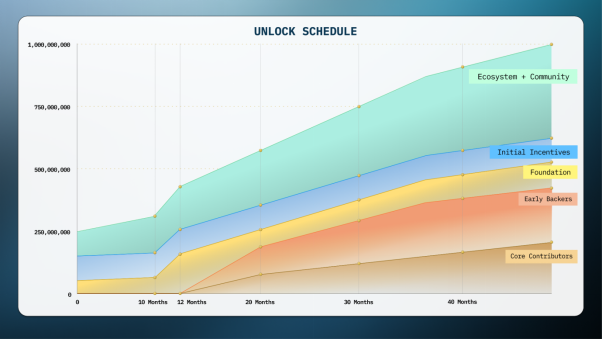
_Source: _story.foundation/blog
- Team and Financing
The Story Protocol team has rich media and political experience, particularly noteworthy is CEO SY Lee, who has interned in the U.S. House of Representatives and the Korean National Assembly, and is a partner at the well-known Korean foundation Hashed. He was also the founder of the novel platform Radish, which is an IP platform in the Web2 field and was ultimately sold for $440 million. Other founding team members, such as Jason Zhao, also have backgrounds from Stanford and other prestigious institutions, attracting top VC financing due to their high-quality team background. According to community news, Story Protocol attracted financing from a16z with just a PPT presentation before the product was officially released. Some in the community claim that Story Protocol is another key public chain layout by a16z following Solana and Sui.
Since 2023, Story Protocol has completed three rounds of large-scale financing, with a total financing scale of $134 million, each round led by a16z. The specific financing details are as follows:
Seed Round Financing: In May 2023, led by a16z, with investment institutions including Hashed and dao5, raising $29.3 million.
Series A Financing: In September 2023, also led by a16z, with investment institutions including Hashed, Samsung Next, and Foresight Ventures, raising $25 million.
Series B Financing: In August 2024, also led by a16z, with investment institutions including Polychain, Cozomo de Medici, and Adrian Cheng, raising $80 million.
- Operational Data
The Story Protocol mainnet officially launched on February 13, 2025. According to Storyscan data, as of the time of writing, the total number of addresses for Story Protocol is 762,000, with a daily transaction volume of 231,000. Additionally, based on data from the official staking page, there are 37 validators on the Story Protocol mainnet, with a total staking amount exceeding 300 million $IP, and an APR of approximately 9.24%. However, the data shows a significant downward trend in active accounts after the mainnet launch and token issuance, with the current trend stabilizing.

Source: Storyscan
According to official data, the main directions of the Story Protocol ecosystem projects include IPFi, AI, and consumer applications, totaling 148 projects. However, it is noteworthy that after researching all current ecosystem projects, this report found that most projects are still in the early stages. Among the 148 projects under the ecosystem, some have ceased operations, while others are striving to catch up.
Among these projects, interesting perspectives include the incorporation of Web2 IP, such as combining with Korean pop culture to create a decentralized "Hollywood" and optimizing the traditional UGC system, which also brings more possibilities to Web3. In the following sections, this report will focus on key projects in the areas of IPFi, AI, consumer applications, and infrastructure.
II. Key Ecosystem Projects
- IPFi
1.1 DeFi - Unleash Protocol
Unleash Protocol is a lending platform based on Story Protocol, with the main goal of increasing the liquidity and leverage of IP. Currently, the assets available for borrowing on Unleash Protocol are limited, only supporting USDC.e, IP, and WETH, with the highest APY for IP reaching 12.31%.

_Source: _app.unleashprotocol.xyz
Unleash Protocol ranks second in the TVL of Story Protocol DeFi, with only a $1.2 million difference from the first place. As of the time of writing, the DeFi TVL of Story Protocol is $30.99 million, while Unleash Protocol's DeFi TVL is $12.59 million, accounting for approximately 40.6%.

Source: defillama
It is worth noting that Unleash Protocol also manages the first AI agent of Story Protocol, Benjamin. Benjamin focuses on DeFAI, aiming to achieve the integration of DeFi and IPFi. However, as of the time of writing, Benjamin's social media has stopped updating.
Overall, Unleash Protocol's positioning is similar to ETH's AAVE, and its long-term development mainly relies on the development level of the public chain Story Protocol. Currently, the token economics of Unleash Protocol have not been announced, and the token has not yet been issued. Additionally, Unleash Protocol is conducting a third round of lending incentive activities, where users can participate to earn $IP token rewards, but user participation appears to be low.
1.2 Perp DEX - Satori
Satori is a multi-chain perpetual contract decentralized exchange that has integrated 12 public chains, including ETH, BNB Chain, Polygon, Base, zkSync, and Scroll. It is noteworthy that Satori's official website does not disclose any collaboration with Story Protocol, only interacting and promoting on social media, and has only integrated trading pairs from the Story Protocol chain on its web app.
Satori raised $10 million in funding from top VCs in 2022, with investment institutions including Polychain, Blockchange Ventures, Coinbase Ventures, and Jump Crypto. According to official data, Satori currently has over 6.55 million total users and a total trading volume exceeding $3.81 million. In terms of products, users can choose to trade on the web app or via Telegram, with leverage trading up to 50 times.
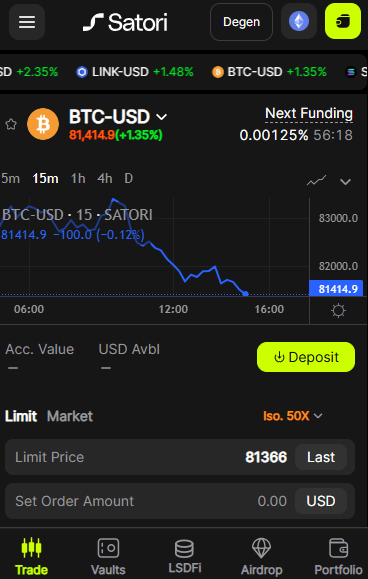
Source: @SatoriFinanceBot
The Satori token has not yet been issued and primarily incentivizes users in the form of points. Currently, Satori is conducting a second season trading airdrop activity, but there are some doubts in the community regarding Satori's activities, as some users have not yet received point rewards from the first season. As it stands, Satori is merely a multi-chain infrastructure supporting Story Protocol, rather than a native DEX, and how it will support the development of Story Protocol's IPFi in the future remains to be observed.
1.3 IP RWAs - Aria and STR8FIRE
A. Aria
Aria has a core mechanism centered on RWA and IP, focusing on token compliance and RWIP, releasing liquidity for RWIP through secondary exchanges and lending markets. Its main products are divided into Aria SPARK and Aria PRIME, where Aria SPARK provides a distributed financing model, allowing supporters and investors to fund creators in creating new IP assets while aligning the interests of all parties. Aria PRIME primarily offers institutional-level IP tokenization funds, providing a bridge for institutions to participate in the IPRWA ecosystem. However, currently, these two products have not officially launched.
Aria has received $10.95 million in liquidity incubation from @Stake_Stone and has signed partial copyrights for songs released by well-known Korean artists such as BLACKPINK, JISOO, and BIGBANG. The Aria token has not yet been issued, and it recently signed with Selena Gomez for the album "People You Know," which has over 370 million streams on Spotify and over 50 million views on YouTube.
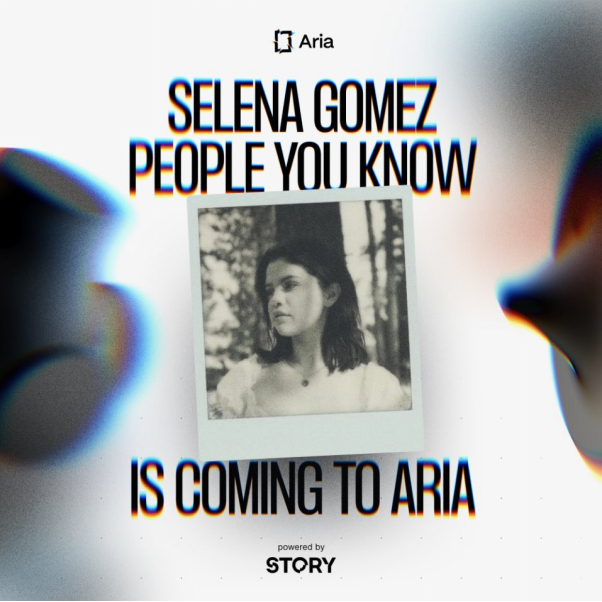
Source: @AriaProtocol_
B. STR8FIRE
STR8FIRE focuses on entertainment IP and is an IP launch platform. Its main pain point is that traditional entertainment IP is primarily controlled by studios and companies regarding corresponding revenue, decision-making, and distribution, preventing fans from directly participating in IP. Therefore, STR8FIRE proposes to tokenize entertainment IP, directly financing in the form of TIPO, and allowing fans to have corresponding voting rights through community governance to decide on IP's commercial activities. STR8FIRE believes that the future of entertainment for fans is not just about watching, but about owning, participating, and benefiting.

Source: @STR8FIREio_
In terms of token economics, investors can stake the native token $STRF to unlock access to high-quality IP. Additionally, $STRF has a burn mechanism, which activates the token burn mechanism each time a new IP is issued. In future plans, STR8FIRE will also layout the RWA market, IP funds, and flagship IP. STR8FIRE is committed to creating an ecosystem where fans can benefit.
STR8FIRE positions itself as a decentralized Hollywood, currently showcasing only 7 IPs on its official website. However, in the official documentary of Story Protocol, "Balistyx," it is mentioned that more entertainment IPs will join in the future, including American actors and JD @DavidFaustino.
STR8FIRE was launched in March 2024 and is one of the longer-running projects within the Story Protocol ecosystem. It has received funding from @shimacapital, @GSRio, @MVenturesLabs, and @TaisuVentures. Currently, the native token of STR8FIRE has not yet been issued.
- AI
2.1 Generative Music IP - Solo AI
SoloAI is the first AI agent supported by the Story Protocol Foundation, combining AI-generated music with the token $IP, helping creators to explore new realms of music creation. SoloAI has secured $2 million in funding from top VC Hongshan. The SoloAI project is set to launch in August 2024 and has a certain user base, with over 30,000 users participating in previous events and a total of over 220,000 on-chain transactions.
It has three main features: customizable music creation, allowing users to generate music based on their specific needs; high-quality music generation based on the DiT PPL framework; and lowering the barriers to music creation by providing an easy-to-use interface and API integration, enabling more people to participate in music production.
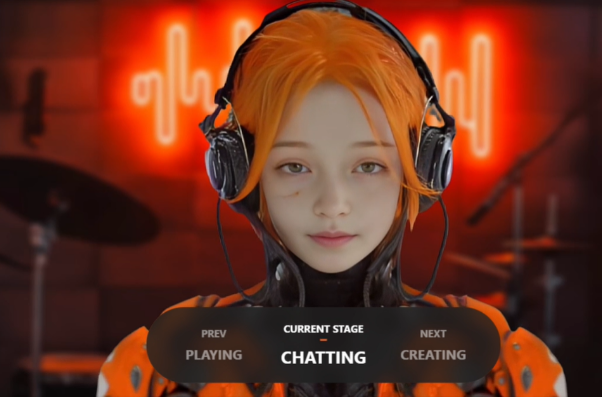
_Source: _soloai.io
Solo AI enhances the AI training model through recursive data collection to achieve a fully self-hosted independent AI music generation system. All music generated by Solo AI is entirely original, thus avoiding infringement on existing music. In future plans, Solo AI aims to achieve complete on-chain IPFI through SOLO AMM (automated market maker), creating a vibrant ecosystem for music IP finance.
Overall, Solo AI focuses on music IP, with music IPFI as the ultimate goal, dedicated to building a music IP financial ecosystem. Solo AI has also received support from top VCs, but based on the project's development progress, product updates are relatively slow, and the existing integrated IP is limited, with partnered creators not bringing in new traffic to the project.
2.2 IP Creation Platform - Playartsdotai
Playartsdotai is an AI agent based on Story Protocol, supporting @arbitrum, @BNBchain, @monad_xyz, and others. It allows users to generate and edit works, tokenizing them for trading and value accumulation. Notably, Playartsdotai has joined NVIDIA Inception, gaining more resource support. Through Story Protocol's ATCP/IP protocol, it enables autonomous interaction, negotiation, and trading of IP between AI agents, providing users with a more convenient, secure, and fair creative experience.
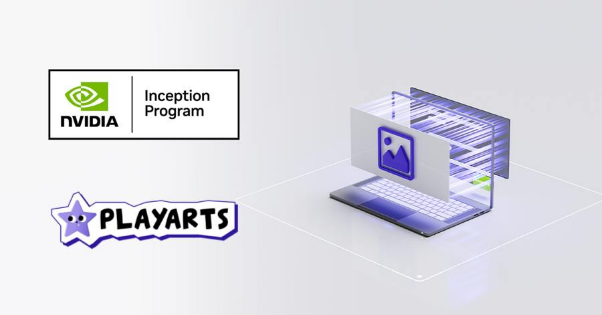
Source: @playartsdotai
Technically, Playartsdotai expands the AI ecosystem using a customizable framework, image training data validators, and AI models with vGPU virtualization. Through detailed model customization, strict data validation, and efficient training methods, PlayArts enables users to unlock new possibilities for AI-assisted creativity.
Playartsdotai was established in October 2024 and is primarily community-driven, with the official team regularly conducting community incentive activities. In February 2025, Playartsdotai joined the community AppWorks, focusing on market expansion in Southeast Asia, gaining more resource support. Official data shows that Playartsdotai currently has over 300,000 total users, generated over 320,000 artworks, and has exceeded 1 million total on-chain transactions.
2.3 IP Meme - WhatTheFreg
WhatTheFreg is the first ATCP/IP generated meme on Story Protocol, comparable to $PEPE. Its main feature is the satirical AI agent that mocks fake memes, thus becoming the ultimate guardian of intellectual property. Therefore, WhatTheFreg is referred to as the "Batman of Intellectual Property," depicted as a fierce protector and destroyer, challenging false and derivative content in the chaotic environment of Web3.
As an AI-generated meme, WhatTheFreg is deeply integrated with Story Protocol and its ecosystem projects. For instance, in terms of token distribution, about 50% of WhatTheFreg's native token $WTF is allocated to incentives related to the Story Protocol ecosystem. Additionally, WhatTheFreg conducts numerous airdrops and encourages users to participate in staking to earn other token incentives within the Story Protocol ecosystem.
However, currently, the community atmosphere of WhatTheFreg is not very high, and market sentiment lacks a strong trigger point, with few users participating in community incentive activities.
- Consumer Applications
3.1 IP NFTs Market - Color
Color is the main NFT market of Story Protocol, where users can create, trade, and browse IP assets, licenses, and more on its website. Color serves as a good case for observing the ATCP/IP protocol, as users register IP, trade IP, etc., based on the ATCP/IP protocol. There is limited publicly available information about Color, and the team is currently anonymous. The minting channel for the native NFT Color's Cats closed on February 19, with a total of 928 minted. Currently, Color's Cats has launched on the secondary market, with a floor price of about 12 $IP.
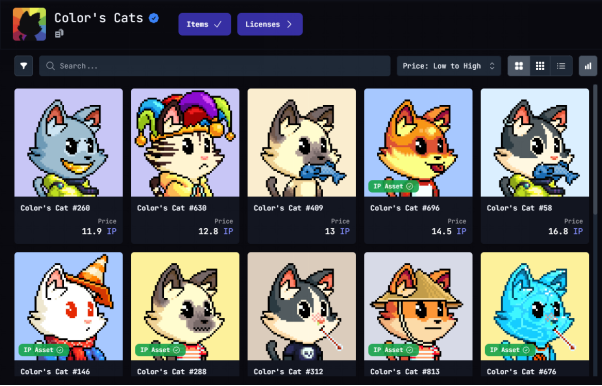
_Source: _colormp.com/leaderboard
The Color project was launched in August 2024, and at the initial stage of project operation, Color participated in the Story Protocol's Iliad testnet activities, where Color had over 40,000 users, nearly 80,000 NFT holders, and a total NFT minting volume exceeding 3.2 million.
Currently, the Color project has not seen many product updates, and the IP NFTs it created are not widely circulated in the market. From the overall community participation perspective, most activities are based on projects within the Story Protocol ecosystem, such as holding NFTs to receive airdrops of other project tokens, without additional traffic injection.
3.2 IP Memecoin Launchpad - Spotlight Protocol
Spotlight Protocol believes that most current memecoins are PVP, which is an unsustainable phenomenon. Therefore, Spotlight Protocol aims to address this issue from two aspects. First, it believes that memecoins are not without value; like traditional IP, memecoins also hold value. Thus, it aims to consolidate the value of memecoins. Secondly, many memecoins currently exhibit a divide between IP grantors and the community. For example, in the previous BNB Chain narrative involving CZ's pet dog, the token $BROCCOLI generated multiple tokens, leading to various PVP phenomena. Spotlight Protocol believes that multiple forces can create a win-win situation. Therefore, it can build a single memecoin, with IP meme holders deciding which project has better development potential.
Spotlight Protocol has released the AI agent @SpottyIP and the Telegram bot Spotlight Bot. Based on @SpottyIP, users only need to add a name and description for the asset to create IP assets or tokens with one click. The Spotlight Bot serves as an intelligent tracking tool that can obtain real-time data on tokens and IP assets.
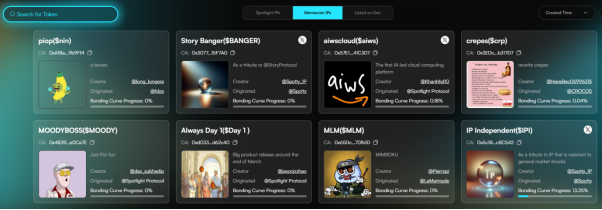
_Source: _app.spotlightprotocol.com/tokens
Spotlight Protocol joined Story Protocol in October 2024 and also participated in the Story Protocol testnet activities. From the perspective of problem-solving logic, Spotlight Protocol has identified market pain points, but in terms of actual problem resolution, it has not yet provided a perfect solution. Currently, Spotlight Protocol has only a few unknown memecoins addressing the actual discrepancies in memecoins, lacking strong community consensus.
3.3 IP UGC Platform - BlockBook
BlockBook is a platform focused on user-generated content (UGC), helping creators earn more income and recognition through its integration with Story Protocol. BlockBook shares a similar vision with Story Protocol, aiming to reshape the ecosystem of content creation and consumption to make it fairer, more transparent, and mutually beneficial.
BlockBook has joined the incubation program of @OrangeDAOxyz, gaining more funding and resource support. Currently, BlockBook is collaborating with actor @LaurenceFulle, where users can participate in visual/text comments on artworks to earn incentives such as NFTs and tokens.
In terms of product, BlockBook is similar to Web2 UGC content. Currently, users need to register via email to log in and post related content. Interestingly, users must pay a small fee to purchase corresponding points to participate in content creation on the platform.
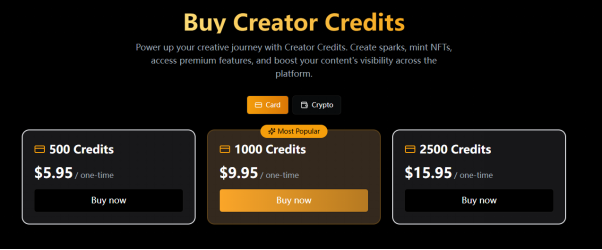
_Source: _blockbook.app/credits
Official data shows that BlockBook currently has over 200,000 total users, with over 530,000 submitted contents and 21.12 million creators. However, in terms of actual community participation, the number of participating community users is not high. Currently, the BlockBook token has not been issued, and user incentives are mainly in the form of points.
- Infrastructure
4.1 Cross-Chain Bridge - deBridge
deBridge is a multi-chain cross-chain bridge and an important infrastructure in the DeFi space, supporting data transfer between different chains. The public chains supported by deBridge include mainstream public chains like Solana and Ethereum, with Solana being its native public chain, and Story Protocol being one of its supported public chains. Notably, deBridge holds over 50% of the market share in the entire cross-chain bridge market for Solana, making it a significant infrastructure on the Solana chain. Additionally, deBridge has secured $5.5 million in funding from ParaFi Capital, SkyVision Capital, GSR, and has also attracted attention from CZ.
On-chain data shows that deBridge's average daily settlement volume is approximately $19.16 million. Since the issuance of its token, deBridge's adoption rate has shown a trend of gradual growth. According to defillama data, deBridge ranks ninth in total value locked (TVL) among all cross-chain bridge protocols.

Source: defillama
Furthermore, deBridge is continuously expanding its business scenarios, which allows it to generate ongoing revenue logically. In terms of adoption, deBridge is also expanding to new public chains, including SonicLabs and HyperliquidX. Therefore, the community generally views deBridge as a cash cow project with positive revenue.
4.2 Developer Services - Gelato
Gelato is a decentralized robot network that allows Web3 developers to automatically execute smart contracts on chains like Ethereum, Polygon, and Story Protocol. Gelato has received funding from Dragonfly, Hack VC, Animoca Brands, and has been deeply involved in the developer services field for many years, forming a relatively complete suite of developer services.
Based on Story Protocol, Gelato has developed a unique Gelato Story. Gelato Story helps developers build random IP applications without gas fees automatically. Additionally, it offers more advanced features, including automatic triggering of royalty sharing, gasless IP licensing, fair unlocking of quality IP, cross-platform royalty circulation, and automatic adjustment of expenses based on usage.
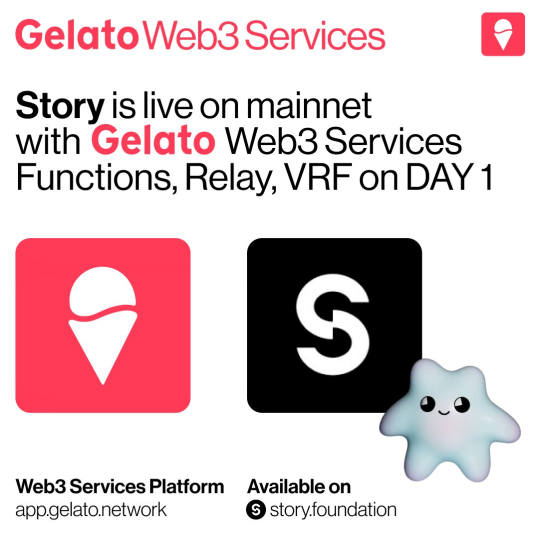
Source: @gelatonetwork
The total supply of Gelato's native token $GEL is 420 million, of which 97% of the tokens have been unlocked. The main functions of the $GEL token are governance and staking, but currently, the frequency of community governance in the ecosystem is not high, and the number of users participating in the staking section is also low. Overall, Gelato's revenue-generating ability is limited, and the incremental value that Gelato Story brings to Story Protocol needs further observation.
- Future Outlook
Story Protocol has opened a new track by putting IP assets on-chain, fundamentally changing the interaction between creators and intellectual property. It provides a more open, transparent, and automated way of IP management. This report believes that the application scope of Story Protocol is very broad, and there are significant market opportunities. However, Story Protocol also faces challenges in incentive mechanisms, IP aggregation, and the implementation of AI agents. If Story Protocol can effectively address the current difficulties and promote the industry to form a standardized on-chain IP operation model, it will have the opportunity to reshape the IP industry and bring new growth opportunities for creators, users, and developers.
- Market Opportunities
The application scope of Story extends far beyond the traditional IP industry, with RWA, GameFi, and even the metaverse benefiting from it. Game developers can issue on-chain IP through Story and allow players to create derivative content, forming a true user co-creation economy; the entertainment industry, including film and music, can utilize Story for transparent revenue distribution, reducing intermediary cuts; brand owners can leverage decentralized IP licensing mechanisms to enhance market dissemination flexibility. Overall, Story Protocol is expected to develop into a leading IP infrastructure in the Web3 space.
- Risk Analysis
At the same time, Story Protocol faces numerous challenges. First, it needs to resolve the incentive mechanism issues among creators, contributors, and the platform; secondly, Story Protocol faces the challenge of aggregating IP. From the current situation, the stimulation effect of introducing Korean wave culture or American IP from the Web2 field is not significant, and Story Protocol needs more leading IP to drive it; finally, like other AI agents, the ATCP/IP framework also faces implementation issues, as only applications that meet actual user needs can succeed in the market.
- Conclusion
Story Protocol represents an important exploratory direction in the decentralized IP field and is expected to become a significant infrastructure for future Web3. Currently, the ecosystem projects of Story Protocol cover a wide range, but most are still in the early exploration stage. The current influx of Korean wave culture and the introduction of American film and television IP elements have not brought new growth points to the ecosystem. Its long-term success will depend on optimizing the token economic mechanism, aggregating IP, and the application of AI agents. If Story Protocol can effectively address the current challenges and promote the industry to form a standardized on-chain IP operation model, it will have the opportunity to reshape the IP industry and bring new growth opportunities for creators, users, and developers.
免责声明:本文章仅代表作者个人观点,不代表本平台的立场和观点。本文章仅供信息分享,不构成对任何人的任何投资建议。用户与作者之间的任何争议,与本平台无关。如网页中刊载的文章或图片涉及侵权,请提供相关的权利证明和身份证明发送邮件到support@aicoin.com,本平台相关工作人员将会进行核查。




